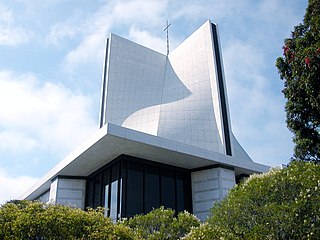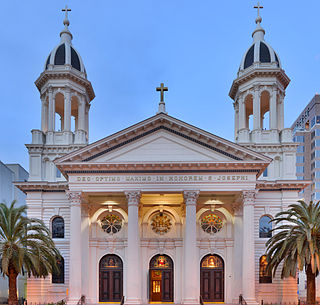
The Archdiocese of San Francisco is a Latin Church ecclesiastical territory or diocese of the Catholic Church in the northern California region of the United States. The Archdiocese of San Francisco was erected on July 29, 1853, by Pope Pius IX and its cathedral is the Cathedral of Saint Mary of the Assumption.

The Cathedral Basilica of St. Joseph is a historic Catholic church in Downtown San Jose that serves as the cathedral for the Diocese of San José in California, with the distinction of minor basilica.

Francis Borgia was a Spanish Jesuit priest. The great-grandson of both Pope Alexander VI and King Ferdinand II of Aragon, he was Duke of Gandía and a grandee of Spain. After the death of his wife, Borgia renounced his titles and became a priest in the Society of Jesus, later serving as its third superior general. He was canonized on 20 June 1670 by Pope Clement X.

Joseph Sadoc Alemany y Conill, O.P. was a Spanish Catholic clergyman, who served most of his career in California. He served as the first Bishop of Monterey (1850–53) and then as Archbishop of San Francisco (1853–84). He was a member of the Dominican Order.

Loyola School is an American Jesuit high school on the Upper East Side of the Manhattan borough of New York City New York, founded in 1900 by the Society of Jesus. It is located two city blocks east of Central Park and Museum Mile on 83rd Street and Park Avenue.

Saint Ignatius Church is on the campus of the University of San Francisco (USF) in San Francisco, California. The church serves a parish of the Archdiocese of San Francisco and is the university's chapel. Saint Ignatius Church is staffed by priests of the Society of Jesus and is dedicated to the Society's founder, Ignatius of Loyola.
Nicholas Congiato was an Italian-born Jesuit priest. He was born in Cagliari, Sardinia and entered the Society of Jesus, an order of the Roman Catholic Church, when he was fourteen years of age. After his initial education, he went to Turin, Italy, for advanced studies in philosophy. Congiato then became Vice-President of the College of Nobles in Turin and held a similar position at the Jesuit College in Fribourg, a city in Switzerland.

The Basilica of St. Joseph is a Roman Catholic church located in Alameda, California. Its history dates back to early settlement of the City of Alameda, California. A former mission church of St. Anthony's in Oakland, the parish of St. Joseph's was established in 1885. It is part of the Diocese of Oakland. The Basilica was added to the National Register of Historic Places on September 18, 1978.

Lawrence Scanlan was an Irish-born American prelate of the Catholic Church. A missionary and pioneer bishop, he served as the first Bishop of Salt Lake from 1891 until his death in 1915.

The Church of St. Ignatius of Loyola is a Catholic parish church located on the Upper East Side of Manhattan, New York City, administered by the Society of Jesus (Jesuits). The parish is under the authority of the Archdiocese of New York, and was established in 1851 as St. Lawrence O'Toole's Church. In 1898, permission to change the patron saint of the parish from St. Lawrence O'Toole to St. Ignatius of Loyola was granted by Rome. The address is 980 Park Avenue, New York City, New York 10028. The church on the southwest corner of Park Avenue and 84th Street is part of a Jesuit complex on the block that includes Wallace Hall, the parish hall beneath the church, the rectory at the midblock location on Park Avenue, the grade school of St. Ignatius's School on the north midblock location of 84th Street behind the church and the high school of Loyola School at the northwest corner of Park Avenue and 83rd Street. In addition, another Jesuit high school, Regis High School, occupies the midblock location on the north side of 84th Street. The church was added to the National Register of Historic Places on July 24, 1980.
Robert Louis Whelan was an American prelate of the Roman Catholic Church. He served as bishop of the Diocese of Fairbanks in Alaska from 1969 to 1985.

The University of San Francisco (USF) is a private Jesuit university in San Francisco, California. The university's main campus is located on a 55-acre (22 ha) setting between the Golden Gate Bridge and Golden Gate Park. The main campus is nicknamed "The Hilltop" and is split into two sections within a block of each other. Part of the main campus is located on Lone Mountain, one of San Francisco's major geographical features. Its close historical ties with the City and County of San Francisco are reflected in the university's traditional motto, Pro Urbe et Universitate.
Aloysius Masnata, (S.J.) was the 5th president of Santa Clara University, California, United States. He was a Genoese priest. At the age of seventeen he was admitted into the novitiate of the Society of Jesus. After studying philosophy and rhetoric and teaching for a year, he was sent to Vals, France, for the study of theology. After his study in France, he immigrated to the United States with other Jesuits after ordination and completed his fourth year of theology at Georgetown College along with Rev. Salvator Canio and Rev. Joseph Bixio. After his study he spent four years teaching rhetoric at Frederick, Maryland, where he was minister and socius to the master of novices. In 1854 Masnata S.J. sailed to California through Panama and arrived in San Francisco, United States, along with Fr. Charles Messea S.J. and Fr. Anthony Maraschi S.J. In 1865 he was appointed Santa Clara University's fifth president successor of the presidency of Burchard Villiger. In 1868, shy and lacking in proper English, Masnata was replaced by Aloysius Varsi. In 1873 Fr. Aloysius Masnata, S.J. served as the 6th president of San Francisco's St. Ignatius College. On November 18, 1886, Aloysius Masnata died in Los Gatos, California.

Saint Wilfrid's Church is a Roman Catholic church run by the Society of Jesus, in the city centre of Preston, Lancashire, England. It was built in 1793 and is situated between Fishergate and Winckley Square on Chapel Street.

Michael Charles Barber, SJ is an American prelate of the Roman Catholic Church who has been serving as bishop of the Diocese of Oakland in California since 2013.
Anthony Joseph Schuler was an American prelate of the Catholic Church. A member of the Society of Jesus, he served as the first Bishop of El Paso from 1915 to 1942.

Holy Rosary Church is a Roman Catholic Parish church in Guelph, Ontario, Canada. It was originally part of the parish of Church of Our Lady Immaculate, Guelph. It was founded in 1956. Since 2001, it has been administered by the Society of Jesus.

Samuel A. Mulledy was an American Catholic priest and Jesuit who served as president of Georgetown College in 1845. Born in Virginia, he was the brother of Thomas F. Mulledy, who was a prominent 19th-century Jesuit in the United States and a president of Georgetown. As a student at Georgetown, Samuel was one of the founding members of the Philodemic Society, and proved to be a distinguished student, which resulted in his being sent to Rome to complete his higher education and be ordained to the priesthood. Upon his return to the United States, he became the master of novices at the Jesuit novitiate in Maryland, before being named president of Georgetown. He sought to be relieved of the position after only a few months, and returned to teaching and ministry.















